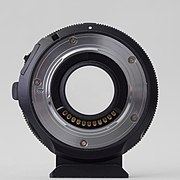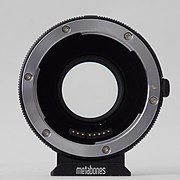Telecompressor
A telecompressor , often Weitwinkelkonverter , Focal Reducer or Turbo Adapter , English Telecompressor , Focal Reducer , Speed Booster or SpeedBooster called an optical is lens adapter for camera lenses having the opposite effect of a tele-converter . It looks similar to a teleconverter and is also mounted between the lens and the camera. It reduces the focal length of the optical system by a specified factor, at the same time the light intensity increases by this factor and the exposure times are shortened accordingly with the same exposure index.
use
Telecompressors are often used in amateur astronomy to enable telescopes to take photographs of objects that are closer or larger than would be possible without a telecompressor. Telecompressors are also used in general photography. It should be noted that the lens must illuminate a larger image circle than would be necessary for the film or image sensor format, as the image circle is reduced by the telecompressor. It is therefore possible, for example, to use a lens for the 35mm format on a camera with an image sensor in APS-C format or Micro Four Thirds format .
Passive telecompressors
Purely optical telecompressors without electronic components cannot transmit data between the lens and the camera housing , so that the corresponding information and function is not available. For example, an aperture number set on the lens or the status of the image stabilizer is not transmitted to the camera body, and the lens's autofocus motor cannot be activated in order to adjust the distance .
Active telecompressors
- Digital telecompressor (0.64x) for Canon EF lenses on Micro Four Thids camera housings
Connection for Micro Four Thirds camera housing with eleven gold contacts
Connection for Canon EF small picture lens with eight gold contacts
Telecompressors are available for some mirrorless system cameras with APS-C or MFT sensors, which enable the adaptation of 35mm lenses while transmitting electronic information between the lens and the camera body. These optical devices can also be equipped with their own processor and firmware . The conversion and transmission of the electrical signals can lead to a loss of speed when controlling the distance setting. Furthermore, some aberrations can increase towards the corners of the image .
Fixed telecompressors
Nikon's early E2 and E3 digital cameras used a built-in telecompressor so that F lenses could be used with the camera's small 2/3 "sensor without taking a format factor into account . This increased the camera's lowest exposure index to one for the Time unusually high value of ISO 800.
calculation
Under the simplifying assumption that the main planes of a lens with the focal length and a telecompressor with the focal length are superimposed, the focal length of the entire system of lens and telecompressor can be determined using the following relationship:
The telecompression factor can be defined from the ratio of the focal lengths of the overall system and the lens used:
The focal length of the entire system can thus be expressed as follows:
This results in:
respectively
See also
Individual evidence
- ↑ Benjamin Kirchheim: Speed booster lens adapter for more light intensity , digitalkamera.de, January 18, 2013, accessed on November 13, 2019
- ↑ a b c Connecting cameras and lenses: Trend towards intelligent adapters , test.de from June 21, 2018, accessed on June 25, 2018
- ↑ Curt Bauer: Speedbooster: More light for your pictures , Chip.de, July 11, 2019, accessed on November 13, 2019
- ↑ Adapter improves the light intensity of lenses. Golem.de, January 15, 2013, accessed December 4, 2013 .
- ↑ Gottfried Schröder: Technical Optics , Chapter 2.2.4. Multistage systems , Vogel Buchverlag, Würzburg, 5th edition (1986), ISBN 3-8023-0067-X
- ↑ Peter Katreniak: 2. Focal reducer , K3's Astronomy of November 11, 2001, accessed on June 25, 2018











